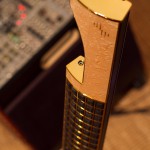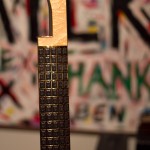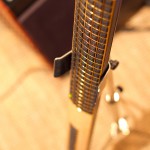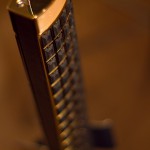 If you’ve seen my “Learning scales” video, you know that through the scales selection mode it’s possible to set up any scale you like and to switch to it while playing. This mode allows you to browse for eight different scales using the row of orange keys and at any later moment use the row of adjacent red keys to select which scale you want to activate. The currently active scale is indicated by one of the red keys being lit green. You can similarly select the starting note of the scale (the tonic) through another mode. This is then all later saved together with your user setup.
If you’ve seen my “Learning scales” video, you know that through the scales selection mode it’s possible to set up any scale you like and to switch to it while playing. This mode allows you to browse for eight different scales using the row of orange keys and at any later moment use the row of adjacent red keys to select which scale you want to activate. The currently active scale is indicated by one of the red keys being lit green. You can similarly select the starting note of the scale (the tonic) through another mode. This is then all later saved together with your user setup.
The factory setup uses the following scales:
- natural major
- harmonic minor
- melodic minor
- chromatic
- blues
- pentatonic major
- diminished
- whole tone
The advantage of working with dynamically switched scales is that you always use the same fingering, meaning that a finger always plays the same key and doesn’t have to move around.
On a piano for instance, you have to know when to play the white or the blacks keys and since there is no black key between the E-F and B-C white keys, the patterns that you play are drastically different when the tonic (first note of the scale) or the scale changes. This makes learning scales a huge effort that can take many years to master. Additionally, it’s not possible to play microtonal tunings or scales on a piano since it’s fixed to our standard western octaves with twelve notes.
Another way of looking at the Eigenharp approach is that the notes aren’t physically bound to the keys, but that you learn how to express yourself with your fingers and then have full control over the sounds and notes that are being played. Some might think that this is confusing, but in reality it’s liberating. To me it feels like open tunings on a guitar, where you change the standard tuning of the six strings to bring out new ideas, possibilities and sounds. Any of the scales and chords that you spent years to learn on the standard tuning have no use in an open tuning. Instead of being limited by theory and established habits, you have to trust your ears again and start finding interesting new ideas. Just like with the Eigenharp, this doesn’t prevent you from playing in a standard setup (chromatic scale), it just opens up this wonderful intuitive world for those that are allured by it.
One limitation of selecting a particular scale is that there is currently no way to play notes that are not part of the active scale. There’s thus currently no way of manually flattening or sharpening notes. However, this has been brought up on the Eigenharp users forums and Eigenlabs is actively working on a solution.
The current plan is to add the concept of scale modifiers. This is a much more general solution than just allowing for semi tones up and down as it will allow scales to tie arbitrary up and down offsets to its intervals. Given the endless variety of scales that are possible on the Eigenharp, it’s encouraging that Eigenlabs goes further than a quick fix based on semi-tones but is developing a general purpose solution that will make sense in even the weirdest of scales. Once these modifiers are defined, it will be possible to assign keys on the Eigenharp to trigger those offsets during playing, similar to how a concert harp allows players to use a foot pedal to shift its diatonic scale a semi-tone up and down.
Another feature that is being developed is the possibility to create scales that require several simultaneous key presses for a single note, which is similar to how wind instruments work. This will allow the range of the Pico to be dramatically increased, at the downside of not being able to play chords . It will however also allow you to set up key combinations for out-of-scale notes.





